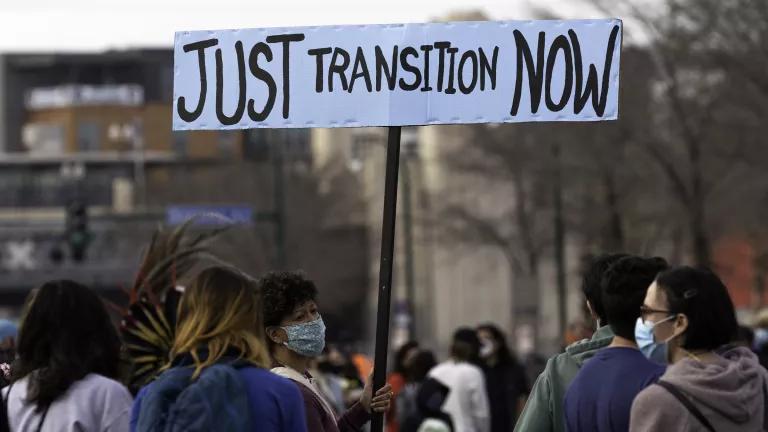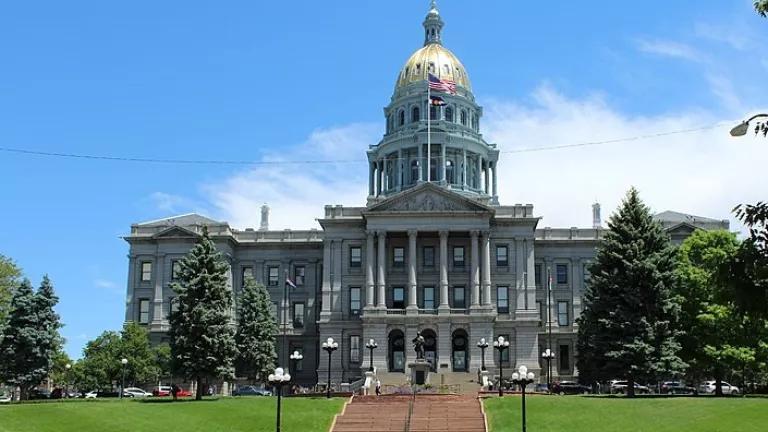Colorado Must Center Equity in Climate Action
Historical & present-day environmental racism threatens the health, economic prosperity, and well-being of marginalized communities across Colorado. That's why we're proud to have signed on to a letter calling for equity to be centered in climate action.

Equity and environmental justice must be centered in Colorado climate action. This is the message made loud and clear by 31 organizations, including NRDC, who submitted recommendations to the Colorado Department of Public Health and Environment in response to the state’s draft equity framework. The recommendations focus on the need to:
- Identify and analyze specific historic and ongoing sources of environmental, energy, and climate injustice
- Create meaningful community engagement by sharing and shifting power and decision making, not solely through sharing information; and
- Ensure equitable climate outcomes by taking concrete steps to reduce the harmful pollution that disproportionately impacted communities unjustly bear and improve environmental, health, and economic outcomes in disproportionately impacted communities.
The full letter and recommendations can be found below. The deadline to submit comments is April 5th.
March 25, 2021
To: climatechange@state.co.us
Subject: Equity Framework Comments
Dear CDPHE,
Historical and present-day instances of environmental racism continue to threaten the health, economic prosperity, and well-being of marginalized communities across Colorado. All people deserve the same right to clean air and water; however, state policies and corporate pollution have disproportionately polluted Black, Indigenous, Latinx, and other communities of color, and left them with less access to economic and social resources. Many communities in Colorado—especially rural—are also disproportionately impacted by the economic transition from traditional fuel sources. The oil and gas, electric generation, transportation, and manufacturing industries have covered towns and cities in hazardous smog, replaced vibrant economies with dependent, boom and bust ones, created and exacerbated serious health issues like respiratory diseases and asthma, and eroded local autonomy by disenfranchising disproportionately impacted communities. This cannot continue. Moving forward, we must center equity in climate decision making to ensure a safe and just future—and a transition to a sustainable economy—for all Coloradans.
As the state gathers feedback to inform the final composition of and use for the equity framework, dozens of environmental justice, climate, business, and health advocates recommend that the equity framework must, at a minimum:
- Identify and analyze specific historical and ongoing sources of environmental, energy, and climate injustice;
- Create meaningful community engagement by sharing and shifting power and decision making, not solely through sharing information; and
- Ensure equitable climate outcomes improve environmental, health, and economic outcomes in disproportionately impacted communities; and take concrete steps to reduce the harmful pollution that disproportionately impacted communities unjustly bear.
Improving communication and engagement with disproportionately impacted communities will not resolve the history of active polluting, disenfranchisement, and racism. We must reimagine how decisions are made, and what must be necessary outcomes, by transforming our decision making structures and procedures. Without intentional strategies and clear requirements for equitable outcomes, Colorado will simply perpetuate the unjust status quo.
Naming and Framing the Problem
Environmental racism is the result of intentional institutional structures and decisions designed to encourage economic progress at the expense of Black, Indigenous, Latinx, and additional communities of color. Communities did not do this to themselves, were not consulted, and have in fact fought to defend their communities for decades. The voices of disproportionately impacted rural communities must also be centered through Colorado’s transition to a low carbon economy. The answers to these problems include not only listening to these communities but also taking real, measurable action to remedy historical and ongoing injustices.
This equity framework is a first step in acknowledging that injustice and disproportionate impact are real and must be addressed in a meaningful way. However, the existing equity framework confuses communication with consent. It presupposes that any outcome is justifiable if communities are given the opportunity to share their concerns, regardless of what the concerns were and whether the government takes action to address these concerns. In doing so, the existing draft is more suited to justify continued injustice than to create a new model for equitable climate action.
Recommendations
1.Identify and Analyze Historic and Ongoing Sources of Environmental Injustice
The first step in making progress is to understand our baseline or current state. This requires the Air Quality Control Commission (AQCC) to fulfill statutory obligations to identify disproportionately impacted communities1 and monitor harmful air pollution in those communities.2
Track emission sources and air pollution affecting disproportionately impacted communities.
- H.B. 19-1261 directs the AQCC to promulgate implementing rules and regulations that “provide for ongoing tracking of emission sources that adversely affect disproportionately impacted communities.”3 Without tracking, it will be incredibly difficult to ensure policies are actually reducing pollution.
- The equity framework should inform and initiate AQCC procedures and processes to track quantifiable emissions and health outcomes in disproportionately impacted communities, informed by community, public health, environmental, and other expert feedback on how to best measure those outcomes. Such data can include, but is not limited to:
- Ambient air pollution levels in disproportionately impacted communities;
- Cumulative air pollution burden, over time, in disproportionately impacted communities, constructed with ambient air pollution data;
- Facilities that are in violation of air pollutant emissions permits, where those violations impact disproportionately impacted communities; and
- Pollution sources located in disproportionately impacted communities that are major drivers of air pollution in those communities.
- The equity framework should inform and initiate AQCC procedures and processes to track quantifiable emissions and health outcomes in disproportionately impacted communities, informed by community, public health, environmental, and other expert feedback on how to best measure those outcomes. Such data can include, but is not limited to:
- While the Climate Equity Data Viewer is an important tool to begin to track climate equity burdens, it does not fulfill the mandate to collect specific, granular data on air quality in disproportionately impacted communities and on the facilities that contribute to air pollution burden.
- The equity framework implies that the Climate Equity Data Viewer identifies disproportionately impacted communities but the impacts on tribal and Indigenous communities appear underrepresented.
- It is also unclear on how the Climate Equity Data Viewer will be used to determine disproportionate impact. If the AQCC identifies disproportionately impacted communities using this tool, the equity framework should clearly and transparently specify the relevant variables and the percentile or other methodology that determines disproportionate impact.
- It may be beneficial to pursue a complementary qualitative approach that can approve or adjust identification of disproportionately impacted communities, with their direct input and oversight. For example, the advisory or steering committee(s) could approve additional disproportionately impacted communities through an application or recommendation process, to ensure the Climate Equity Data Viewer is able to be receptive to on-the-ground realities and changing community dynamics.
- The Equity Advisory Committee or another relevant committee should consider, on a case-by-case basis, the historical injustices, displacement, and redlining that determine disproportionate impact.
Make all data transparent and publicly accessible, and articulate how it informs decisions.
- Emission tracking and climate equity data must be accessible and easy to understand.
- The new Working Group or Environmental Justice Council should have a role in guiding the creation of reports that outline environmental, health, and economic benefits and burdens to disproportionately impacted communities, and reports should be made publicly accessible.
- To be an effective tool in advancing equity, data collection must be tethered to a time bound, outcome-oriented, plan to reverse pollution disparities in disproportionately impacted communities.
2. Create Meaningful Engagement that Shares Information and Power
Deep and inclusive community engagement is critically important for trust-building, especially in light of decades of decision making by the state that has excluded frontline communities and resulted in disproportionately negative effects on these communities. Engagement strategies need to shift away from simply informing the community about decision making, and transition to empowering communities to make decisions that will affect their health, environment, and economy.
Commit to accessible community engagement.
- Community engagement opportunities can take a toll on everyone’s time, resources, and energy. To sustain engagement, outreach must be ongoing, iterative, dynamic, and accessible by:
- Using multiple methods of outreach to publicize proposed actions, including disseminating information through community hubs like local schools, social media, social and activity clubs, libraries, or other services;
- Creating outreach materials concerning the proposed action that:
- Are in plain language and avoid the use of jargon, to increase access, trust, and understanding;
- Are translated into the two primary languages spoken in a community;
- Are clear about the possible outcomes and timeline; and
- Inform people of opportunities to provide input on the proposed action,
- Holding public meetings on proposed actions at locations that are trusted by and accessible to community members—such as schools and community centers—rather than in government buildings;
- Scheduling variable times of day, and days of the week, for opportunities for public input on the proposed actions, including at least one weekend time, one evening time, and one morning time;
- Providing transportation support, childcare, and funding for community members to reduce costs of participating; and
- Providing several methods for the public to give input, such as in-person meetings, virtual and online meetings, online comment portals or e-mail and call-in meetings.
Commit to community empowerment.
- Meaningful community engagement goes beyond information sharing to shifting power dynamics.
- Community and committee input should be explicitly included in the decision making documents, such as how feedback from listening sessions was used.
- When community preferences cannot be or are not adopted, the specific reasons for rejecting community input should be documented, as well as what the Colorado Department of Public Health and Environment (CDPHE) will do in the future to address the concern or carry forward community requests in setting near-term future legislative or rulemaking priorities.
- The equity framework should allow community members to object to any finalized decision or rulemaking if the equity framework’s principles weren’t followed or if community preferred solutions were not adequately evaluated, considered, or prioritized.
Commit to creating a culture of equity within CDPHE.
- CDPHE should prioritize internal agency action that makes the agency more trustworthy.
- CDPHE should adopt and build on the draft resolution on systemic racism.
- CDPHE staff should participate in ongoing ally and accomplice, intercultural, and anti-racism trainings.
- CDPHE should create an equity lens or tool to help embed, operationalize, and examine equity across teams and projects.
- CDPHE should pursue diversity equity and inclusion in CDPHE staff and in the composition of commissions.
3. Ensure Equitable Outcomes and Concrete Progress
Climate equity is both a principle to guide the policymaking process and a measurable outcome that state policy must be designed to achieve. The AQCC is bound–morally and statutorily—to prioritize disproportionately impacted communities in crafting and achieving quantifiable, enforceable, and equitable climate action.4
AQCC decision making must protect community health and the environment by reducing harm, or, at a minimum, mitigating expected harms.
- The equity framework should:
- Ensure that rules provide environmental, health, and economic benefits to disproportionately impacted communities, or, at a minimum, no additional burden;
- Provide more clarity about if economic impacts are being weighed against human impacts along with who is benefiting financially and who is suffering from health or other negative human impacts;
- Ensure these equity provisions are central to decision making and that communities can help enforce these practices in the AQCC decision making processes.
Direct resources, funding, and decision making authority to disproportionately impacted communities.
- Fines collected from air pollution permit violations occurring in disproportionately impacted communities should go toward environmental mitigation and remediation in those communities.
- New financial mechanisms should be explored to fund ongoing staff and community needs, such as charging annual Air Pollution Emission Notice fees for greenhouse gas pollution.
The legacies of white supremacy and environmental racism have left Colorado’s Black, Indigenous, Latinx and additional communities of color without the racial, economic, and health justice they need and deserve. While state policy should be an important piece of reckoning and rectifying these injustices, decision making processes are not designed to be accessible to everyone. True inclusion and empowerment will need to deliver on meeting people where they are, respecting their perspectives as valid, and trusting their local knowledge to influence final decisions.
We are eager to continue to work with the state to drive equitable climate action and hope you will take our comments and recommendations into serious consideration.
Sincerely,
Adrienne Dorsey, Executive Director, GRID Alternatives Colorado
Ariana Gonzalez, Colorado Policy Director, NRDC
Beatriz Soto, Directora, Defiende Nuestra Tierra
Christine Canaly, Director, San Luis Valley Ecosystem Council
Cindy Chang, Executive Director, Groundwork Denver
Deyanira Zavala, Executive Director, Mile High Connects
Duncan Gilchrist, Climate Policy Analyst, 350 Colorado
Ean Thomas Tafoya, Colorado Field Advocate, GreenLatinos
Elise Jones, Executive Director, Southwest Energy Efficiency Project
Emily Gedeon, Deputy Director, Colorado Sierra Club
Jeff Neuman-Lee, Wind & Solar Denver
Jessica Gelay, Colorado Government Affairs Manager, Western Resource Advocates
Joseph Salazar, Executive Director, Colorado Rising
Juli Slivka, Conservation Director, Wilderness Workshop
Kate Merlin, Climate and Energy Program Colorado Attorney, WildEarth Guardians
Katie Belgard, Government Affairs Director, Conservation Colorado
Katie Schneer, High Meadows Subnational Climate Policy Fellow, Environmental Defense Fund
Kristi Douglas, Co-Chair North Range Concerned Citizens
Leslie Glustrom, Senior Advisor, Clean Energy Action
Marie Venner, Co-Chair, Colorado Businesses for a Livable Climate
Mayane Barudin, Interior West Director & Tribal Liaison, Vote Solar
Nicole Randall, Director of Strategic & Corporate Partnerships, Corazon Latino
Patricia Ferrero, Organizing Manager, Protégete
Pegah Jalali, Environmental Policy Analyst, Colorado Fiscal Institute
Rebecca Curry, Colorado Policy Advocate, Earthjustice
Sabrina Pacha, Program Manager, Healthy Air & Water Colorado
Sarah Snead, Organizing Representative, Sierra Club - Beyond Coal
Shaina Oliver & Laurie Anderson, Field Organizers, Moms Clean Air Force Colorado Chapter
Stefanie Klass, Co-Chair, CatholicNetwork and Call to Action Colorado
Susan Nedell, Mountain West Advocate, E2
Tracey MacDermott, Chapter Chair, Climate Reality Denver Metro Chapter
Xochi Gaytan, Co-Chair, Colorado Latino Forum
1 The Colorado Air Pollution Prevention and Control Act (APPCA), as amended by H.B. 19-1261, directs the Air Quality Control Commission (AQCC) to “identify disproportionately impacted communities.” C.R.S. §25-7-105(1)(e)(III). Clearly and transparently identifying these communities is a critical step to ensuring the state prioritizes pollution reductions and climate benefits in these communities.
2 H.B. 19-1261 directs the AQCC to promulgate implementing rules and regulations that “provide for ongoing tracking of emission sources that adversely affect disproportionately impacted communities.” C.R.S. § 25-7-105(1)(e)(II).
3 C.R.S. § 25-7-105(1)(e)(II).
4 In H.B. 19-1261, the legislature codified the mandate to reduce greenhouse gas emissions alongside the mandate to reduce air pollution that harms disproportionately impacted communities, requiring the AQCC implementing rules to “include strategies designed to achieve reductions in harmful air pollution affecting [disproportionately impacted] communities.” C.R.S. § 25-7-105(1)(e)(II).




